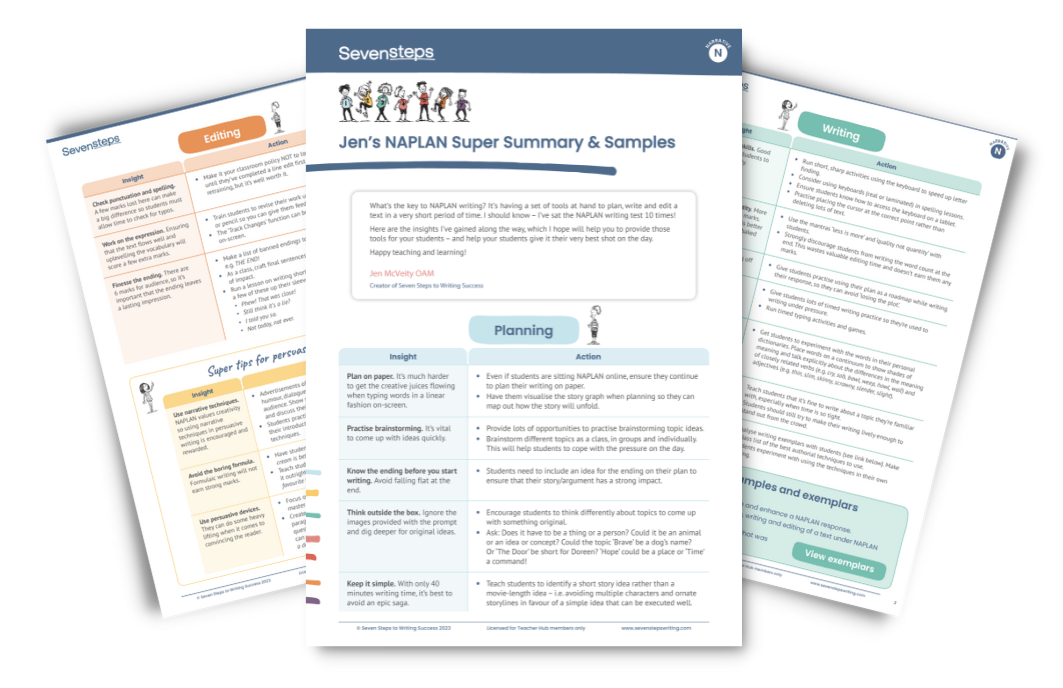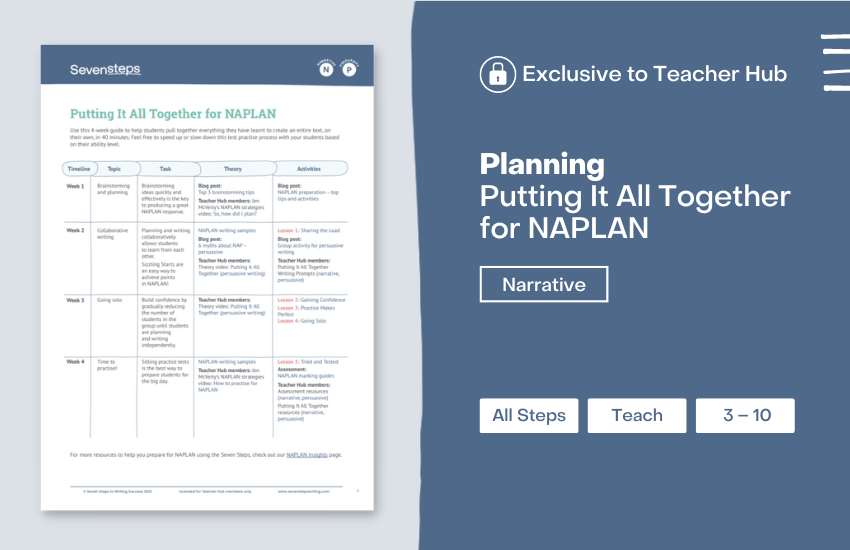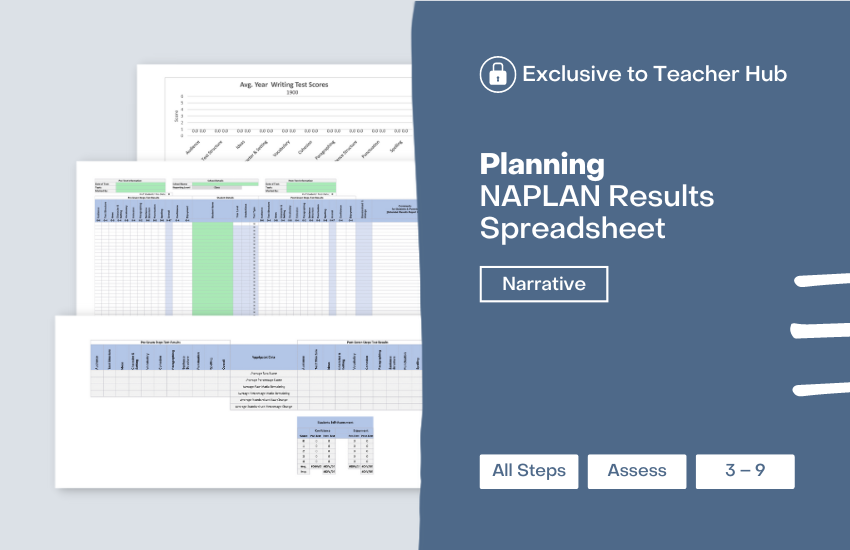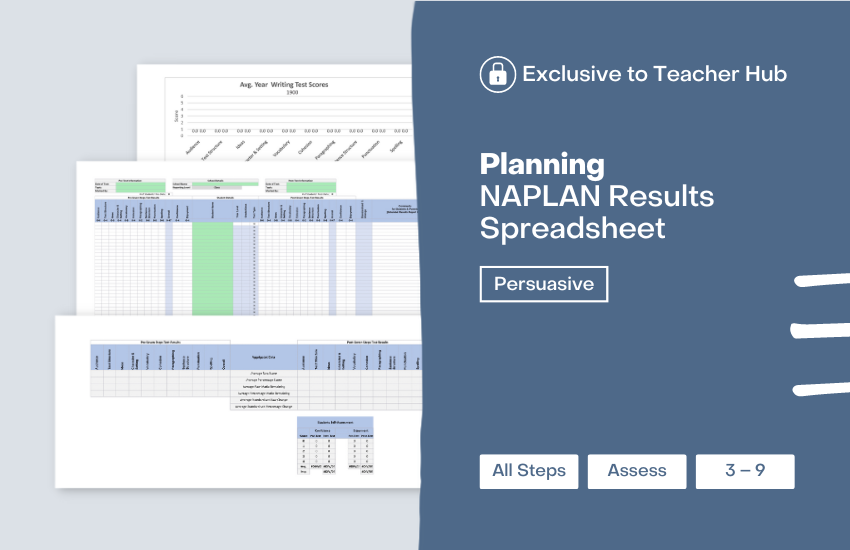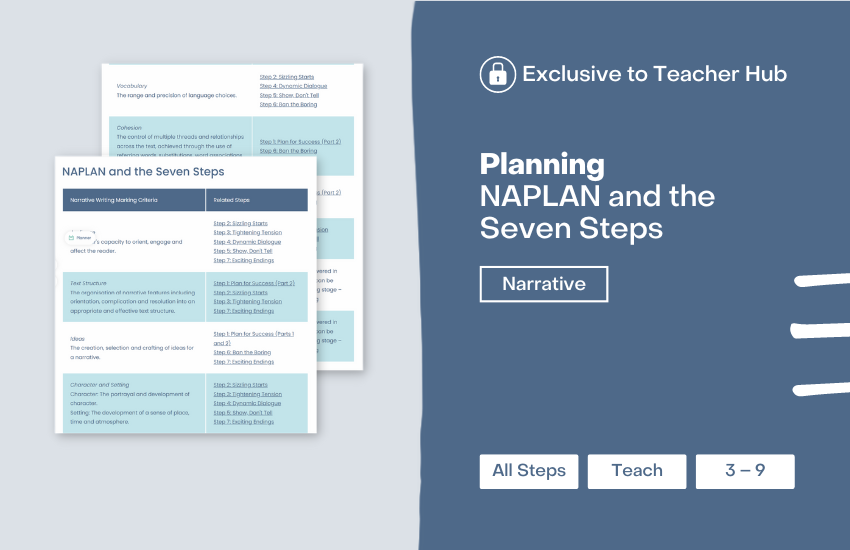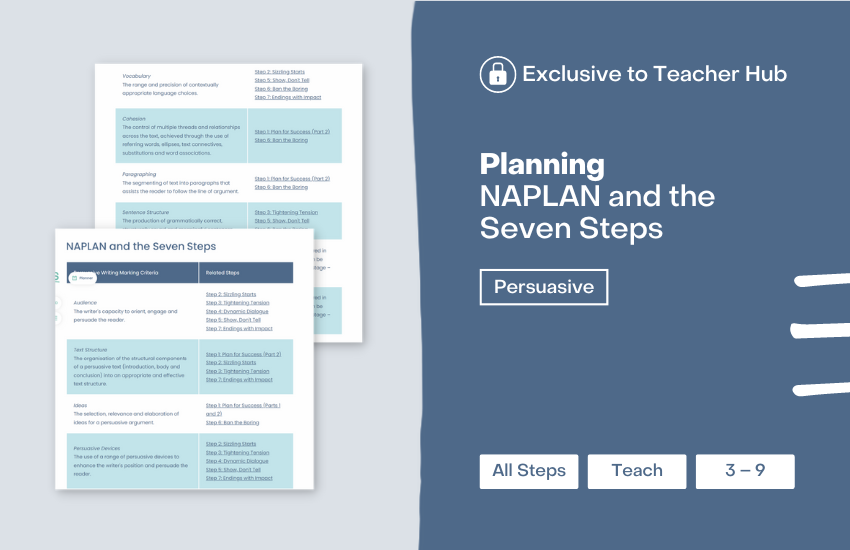No products in the cart.
NAPLAN Writing and the Seven Steps
What does NAPLAN value?
Good news! NAPLAN values great writing. Out of the possible 47 (48 for Narrative) marks, 36 (or 37 for Narrative) are attributed to author-focused criteria like Ideas, Audience, Cohesion, Character & Setting, Persuasive Devices, etc. The ‘secretarial’ side of writing (Spelling and Punctuation) meanwhile only accounts for 11 marks.
As you can see from the NAPLAN Marking Guides for narrative and persuasive, they value writing that is well-rounded and engaging. So, focus on teaching students how to become engaging writers and see the impact that it has on their results.
Build your students’ authorial skills with the Seven Steps
The Seven Steps focuses on teaching students the authorial side of writing – originality, creativity, the craft of writing. Why? Because that is what makes for fantastic writing that readers love.
‘Our writing result in Year 9 is against the national trend which showed a 1.7% drop, where our result went up by 11.4%. I can guarantee our writing success was due to students being exposed to the Seven Steps of Writing Success. Students love it.’
– Valissa Bauer, Literacy Coach
Resources to help improve your students’ NAPLAN Writing results
Jen’s NAPLAN Super Summary & Samples
Check out this handy compilation of Jen’s most valuable takeaways designed to help your students plan, write and edit a response under test conditions. Plus, a collection of the responses she wrote for each NAPLAN topic to help you model great writing in your classroom.
Incorporating these insights and actions into your NAPLAN prep is a sure-fire way to help your students approach the writing test with the confidence they need to perform at their best.

A simple guide to NAPLAN writing
Prepare your students for the NAPLAN writing task by creating great writers.
- Uncover insights into the NAPLAN writing task and ACARA’s expectations.
- Learn what to focus on in the lead-up to NAPLAN to make the biggest difference to your students’ writing.
- Find out how to reflect on the NAPLAN writing task as a class to further students’ learning.
Putting It All Together for NAPLAN
Here’s our suggestion on how to help students pull everything they have learnt together to create an entire text, on their own, in 40 minutes. Feel free to speed up or slow down this test practice process with your students based on their ability level.
Not a Teacher Hub member? You can still get instant access with a free 14-day Teacher Hub trial (no credit card required) – learn more here.

NAPLAN Insights
This collection of NAPLAN resources includes Jen’s Insight videos from her time sitting NAPLAN, as well as resources to help you track and assess NAPLAN preparation and exemplars to model Seven Steps techniques in a test environment.
Not a Teacher Hub member? You can still get instant access with a free 14-day Teacher Hub trial (no credit card required) – learn more here.
Resources to help track your students’ NAPLAN Writing Success
Narrative Results Spreadsheet – NAPLAN
This simple spreadsheet is designed to be used alongside the NAPLAN narrative marking guide. Record and compare your students’ pre- and post-test results for each of the NAPLAN criteria.
The spreadsheet breaks down the data and graphs the results to show the overall improvement in your students’ NAPLAN scores after implementation.
You can also measure the improvement in their levels of confidence and enjoyment.

Persuasive Results Spreadsheet – NAPLAN
This simple spreadsheet is designed to be used alongside the NAPLAN persuasive marking guide. Record and compare your students’ pre- and post-test results for each of the NAPLAN criteria.
The spreadsheet breaks down the data and graphs the results to show the overall improvement in your students’ NAPLAN scores after implementation.
You can also measure the improvement in their levels of confidence and enjoyment.

Not a Teacher Hub member? You can still get instant access with a free 14-day Teacher Hub trial (no credit card required) – learn more here.

NAPLAN and the Seven Steps – Narrative
The Seven Steps can dramatically improve students’ results in the NAPLAN writing task. This resource shows which Steps relate to each of the NAPLAN marking criteria for narrative writing.
Use the table to identify which Steps to focus on to improve particular aspects of students’ writing in preparation for NAPLAN. You can also use it to address any areas of weakness identified by their past NAPLAN results.
Not a Teacher Hub member? You can still get instant access with a free 14-day Teacher Hub trial (no credit card required) – learn more here.

NAPLAN and the Seven Steps – Persuasive
The Seven Steps can dramatically improve students’ results in the NAPLAN writing task. This resource shows which Steps relate to each of the NAPLAN marking criteria for persuasive writing.
Use the table to identify which Steps to focus on to improve particular aspects of students’ writing in preparation for NAPLAN. You can also use it to address any areas of weakness identified by their past NAPLAN results.
Not a Teacher Hub member? You can still get instant access with a free 14-day Teacher Hub trial (no credit card required) – learn more here.
NAPLAN Writing Success
Resource Packs and Video Guides
Help your students approach the NAPLAN writing test with confidence!

NAPLAN insights and stories
Practical tips and insights to help prepare your students for NAPLAN writing.
“I can tell you our Year 5 NAPLAN writing results (which was the only thing going downwards in our results) has improved so much (particularly amongst the targeted boys) that our auditor initially did not believe our data!! He wanted to take it home and study it. Wow!”
Literacy Coach
Our writing result in Year 9 went up by 11.4%! I can guarantee our writing success was due to students being exposed to the Seven Steps. Students love it.
Literacy Coach

School Packages
Become a Seven Steps school
Training and resources to transform student engagement and writing data.





